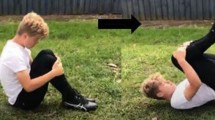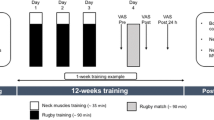Abstract
The neck musculature has an essential role in positioning and stabilising the head and may influence sport performance and injury risk. The objectives of this review are to (1) compare the neck strength of different athletes; (2) report on the outcomes of training programmes; (3) explore the association between neck strength and head stabilisation; (4) examine the relationship between neck strength and sport injury risk; and (5) identify areas for future research. There was a difference in strength between different player positions in football codes, gender and age. Detected differences were partly attributed to variation in neck muscle mass. Neck strength training programmes were generally shown to be effective for untrained and trained participants using dynamic or isometric actions and various types of resistance devices. There was a wide range of reported increases in neck strength; the smallest gains were usually for programmes that utilised lower intensity or frequency. There was limited evidence that greater isometric strength or dynamic training was associated with better head stabilisation during low-level force application, while there is direct evidence of an association between neck isometric training or strength and injury risk. A retrospective analysis of professional rugby union players revealed that isometric training reduced match-related cervical spine injuries and a prospective study found that greater overall isometric neck strength reduced concussion risk in high school athletes. Recommendations for future research include substantiating the link between neck strength and sport injury risk and assessing the effectiveness of neck plyometric and perturbation training on stabilisation and injury risk.
Similar content being viewed by others
References
Ylinen JJ, Julin M, Rezasoltani A, et al. Effect of training in Greco-Roman wrestling on neck strength at the elite level. J Strength Cond Res. 2003;17:755–9.
Olivier PE, DuToit DE. Isokinetic neck strength profile of senior elite rugby union players. J Sci Med Sport. 2008;11:96–105.
Hamilton DF, Gatherer D, Robson J, et al. Comparative cervical profile of adult and under-18 front-row rugby players: implications for playing policy. BMJ Open. 2014;4:e004975. doi:10.1136/bmjopen-2014-004975.
Swain MS, Lystad RP, Pollard H, et al. Incidence and severity of neck injury in rugby union: a systematic review. J Sci Med Sport. 2011;14:383–9.
Naish R, Burnett A, Burrows S, et al. Can specific neck strengthening programs decrease cervical spine injuries in a men’s professional rugby union team? A retrospective analysis. J Sports Sci Med. 2013;12:542–50.
Mihalik JP, Guskiewicz KM, Marshall SW, et al. Does cervical muscle strength in youth ice hockey players affect head impact biomechanics? Clin J Sport Med. 2011;21:416–21.
Lucke-Wold BP, Turner RC, Logsdon AF, et al. Linking traumatic brain injury to chronic traumatic encephalopathy: identification of potential mechanisms leading to neurofibrillary tangle development. J Neurotrauma. 2014;31:1129–38.
Franco JL, Herzog A. A comparative assessment of neck muscle strength and vertebral stability. J Orthop Sports Phys Ther. 1987;8:351–6.
Jacobs K, Nichols J, Holmes B, et al. Isometric cervical extension strength of recreational and experienced cyclists. Can J Appl Physiol. 1995;20:230–9.
Tsuyama K, Yamamoto Y, Fujimoto H, et al. Comparison of the isometric extension strength and a cross-sectional area of neck extensor muscles in college wrestlers and judo athletes. Eur J Appl Physiol. 2001;84:487–91.
Rezasoltani A, Ahmadi A, Nehzate-Khoshroh M, et al. Cervical muscle strength in two groups of elite Greco-Roman and free style wrestlers and a group of non-athletic subjects. Br J Sports Med. 2005;39:440–3.
Hamilton DF, Gatherer D, Jenkins PJ, et al. Age-related differences in neck strength of adolescent rugby players: a cross-sectional cohort study of Scottish schoolchildren. Bone Joint Res. 2012;1:152–7.
Hildenbrand KJ, Vasavada AN. Collegiate and high school athlete neck strength in neutral and rotated postures. J Strength Cond Res. 2013;27:3173–82.
Konranth J, Appleby B. An investigation of cervical strength and anthropometry in professional rugby union players. J Aust Strength Cond. 2013;21:12–8.
Hamilton DF, Gatherer D. Cervical isometric strength and range of motion of elite rugby union players: a cohort study. BMC Sports Sci Med Rehabil. 2014;6:32. http://biomedcentral.com/2052-1847/6/32. Accessed 28 Jan 2016.
Leggett SH, Graves JE, Pollock ML, et al. Quantitative assessment and training of isometric cervical extension strength. Am J Sports Med. 1991;19:653–9.
Axen K, Haas F, Schicchi J, et al. Progressive resistance neck exercises using a compressible ball coupled with an air pressure gauge. J Orthop Sports Phys Ther. 1992;16:275–80.
Pollock ML, Graves JE, Bamman MM, et al. Frequency and volume of resistance training: effect on cervical extension strength. Arch Phys Med Rehabil. 1993;74:1080–6.
Conley MS, Stone MH, Nimmons M, et al. Specificity of resistance training responses in neck muscle size and strength. Eur J Appl Physiol. 1997;75:443–8.
Portero P, Bigard AX, Gamet D, et al. Effects of resistance training in humans on neck muscle performance, and electromyogram power spectrum changes. Eur J Appl Physiol. 2001;84:540–6.
Burnett AF, Naumann FL, Price RS, et al. A comparison of training methods to increase neck muscle strength. Work. 2005;25:205–10.
Lisman P, Signorile JF, Del Rossi G, et al. Investigation of the effects of cervical strength training on neck strength, EMG, and head kinematics during a football tackle. Int J Sports Sci Eng. 2012;6:131–40.
Kramer M, Hohl K, Bockholt U, et al. Training effects of combined resistance and proprioceptive neck muscle exercising. J Back Musculoskelet Rehabil. 2013;26:189–97.
Alricsson M, Harms-Ringdahl K, Larsson B, et al. Neck muscle strength and endurance in fighter pilots: effects of a supervised training program. Aviat Space Environ Med. 2004;75:23–8.
Sovelius R, Oksa J, Rintala H, et al. Trampoline exercise vs. strength training to reduce neck strain in fighter pilots. Aviat Space Environ Med. 2006;77:20–5.
Taylor MK, Hodgdon JA, Griswold L, et al. Cervical resistance training: effects on isometric and dynamic strength. Aviat Space Environ Med. 2006;77:1131–5.
Salmon DM, Harrison MF, Sharpe D, et al. Exercise therapy for improved neck muscle function in helicopter aircrew. Aviat Space Environ Med. 2013;84:1046–54.
Stump J, Rash G, Semon J, et al. A comparison of two modes of cervical exercise in adolescent male athletes. J Manip Physiol Ther. 1993;16:155–60.
Mansell J, Tierney RT, Sitler MR, et al. Resistance training and head-neck segment dynamic stabilization in male and female collegiate soccer players. J Athl Train. 2005;40:310–9.
Geary K, Green BS, Delahunt E. Effects of neck strength training on isometric neck strength in rugby union players. Clin J Sport Med. 2014;24:502–8.
Centre for Evidence-Based Medicine, University of Oxford. Glossary. http://www.cebm.net/glossary/. Accessed 19 Jun 2015.
Tierney RT, Sitler MR, Swanik CB, et al. Gender difference in head-neck dynamic stabilization during head acceleration. Med Sci Sport Exerc. 2005;37:272–9.
Tierney RT, Higgins M, Caswell SV, et al. Sex differences in head acceleration during heading while wearing soccer headgear. J Athl Train. 2008;43:578–84.
Dezman ZDW, Ledet EH, Kerr HA. Neck strength imbalance correlates with increased head acceleration in soccer heading. Sports Health. 2013;5:320–6.
Schmidt JD, Guskiewicz KM, Blackburn JT, et al. The influence of cervical muscle characteristics on head impact biomechanics in football. Am J Sports Med. 2014;42:2056–66.
Gutierrez GM, Conte C, Lightbourne K. The relationship between impact force, neck strength, and neurocognitive performance in soccer heading in adolescent females. Pediatr Exerc Sci. 2014;26:33–40.
Eckner JT, Oh YK, Joshi MS, et al. Effect of neck muscle strength and anticipatory cervical muscle activation on kinematic response of the head to impulsive loads. Am J Sports Med. 2014;42:566–76.
Zhang MR, Red SD, Lin AH, et al. Evidence of cognitive dysfunction after soccer playing with ball heading using a novel tablet-based approach. PLoS One. 2013;8:e57364. doi:10.1371/journal.pone.0057364.
Kerr ZY, Collins CL, Mihalik JP, et al. Impact locations and concussion outcomes in high school football player-to-player collisions. Pediatrics. 2014;134:489–96.
Dainty D, Gagnon M, Lagasse P, et al. Recommended procedures. In: Dainty DA, Norman RW, editors. Standardizing biomechanical testing in sport. Champaign: Human Kinetics Publishers; 1987. p. 80–1.
Jadischke R, Viano DC, Dau N, et al. On the accuracy of the Head Impact Telemetry (HIT) system used in football helmets. J Biomech. 2013;46:2310–5.
Allison MA, Kang YS, Bolte JH, et al. Validation of a helmet-based system to measure head impact biomechanics in ice hockey. Med Sci Sports Exerc. 2014;46:115–23.
McIntosh AS, Patton DA, Frechede B, et al. The biomechanics of concussion in unhelmeted football players in Australia: a case–control study. BMJ Open. 2014;4:e005078. doi:10.1136/bmjopen-2014-005078.
Forbes JA, Awad AJ, Zuckerman S, et al. Association between biomechanical parameters and concussion in helmeted collisions in American football: a review of the literature. Neurosurg Focus. 2012;33(E10):1–6. doi:10.3171/2012.9.FOCUS12288.
Hagel B, Meeuwisse W. Risk compensation: a “side effect” of sport injury prevention? Clin J Sport Med. 2004;14:193–6.
Sugimoto D, Alentorn-Geli E, Mendiguchia J, et al. Biomechanical and neuromuscular characteristics of male athletes: implications for the development of anterior cruciate ligament injury prevention programs. Sports Med. 2015;45:809–22.
Collins CL, Fletcher EN, Fields SK, et al. Neck strength: a protective factor reducing risk for concussion in high school sports. J Primary Prevent. 2014;35:309–19.
Author information
Authors and Affiliations
Corresponding author
Ethics declarations
No source of funding was used in preparation of this article and the author has no conflicts of interest related to the contents of this review.
Rights and permissions
About this article
Cite this article
Hrysomallis, C. Neck Muscular Strength, Training, Performance and Sport Injury Risk: A Review. Sports Med 46, 1111–1124 (2016). https://doi.org/10.1007/s40279-016-0490-4
Published:
Issue Date:
DOI: https://doi.org/10.1007/s40279-016-0490-4




